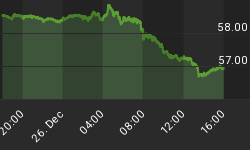The good news is:
• In spite of some deterioration in the indices, new lows have remained insignificant.
The Negatives
New highs and new lows both continued to decline last week.
The first chart covers the past 6 months showing the NASDAQ composite (OTC) in blue and a 10% trend (19 day EMA) of NASDAQ new highs (OTC NH) in green. Dashed vertical lines have been drawn on the 1st trading day of each month.

The next chart is similar to the one above except it shows the S&P 500 (SPX) in red and NY NH, in green, has been calculated using NYSE data.

The Positives
The secondaries outperformed the blue chips and new lows declined.
The next chart covers the past 6 months showing the OTC in blue and a 40% trend (4 day EMA) of NASDAQ new highs divided by new highs + new lows (OTC HL Ratio), in red. Dashed horizontal lines have been drawn at 10% levels for the indicator; the line is solid at the 50%, neutral, level.

The next chart is similar to the one above one except it shows the SPX in red and NY HL Ratio, in blue, has been calculated with NYSE data.

NY HL Ratio rose sharply finishing the week at 78%.
Seasonality
Next week includes the first 4 trading days of July during the 1st year of the Presidential Cycle. The tables below show the daily change, on a percentage basis for that period.
OTC data covers the period from 1963 to 2016 while SPX data runs from 1928 to 2016. There are summaries for both the 1st year of the Presidential Cycle and all years combined.
Average returns for the coming week have been mixed and a little stronger for the blue chips than the secondaries.
Report for the first 4 days of July.
The number following the year represents its position in the Presidential Cycle.
The number following the daily return represents the day of the week;
1 = Monday, 2 = Tuesday etc.



July
Since 1963, over all years, the OTC in July has been up 52% of the time with an average gain of 0.4%. During the 1st year of the Presidential Cycle the OTC in July has been up 77% of the time with an average gain of 2.7%. The best July ever for the OTC was 1997 (+10.5%), the worst 2002 (-9.2%).
The average month has 21 trading days. The chart below has been calculated by averaging the daily percentage change for each of the 1st 11 trading days and each of the last 10. In months when there were more than 21 trading days some of the days in the middle were not counted. In months when there were less than 21 trading days some of the days in the middle of the month were counted twice. Dashed vertical lines have been drawn after the 1st trading day and at 5 trading day intervals after that. The line is solid on the 11th trading day, the dividing point.
In the chart below the blue line shows the average daily performance of the OTC in July over all years since 1963, while the green line shows the average during the 1st year of the Presidential Cycle over the same period.

Since 1928 the SPX has been up 57% of the time in July with an average gain of 1.5%. During the 1st year of the Presidential Cycle the SPX has been up 64% of the time with an average gain of 2.3%. The best July ever for the SPX was 1932 (+37.7%) the worst 1934 (-11.5%).
The chart below is similar to the one above except it shows the average daily performance over all years since 1928 for the SPX in July in red and the average daily performance during the 1st year of the Presidential Cycle, over the same period, in green.

Since 1979 the Russell 2000 (R2K) has been up 47% of the time in July with an average loss of -0.3%. During the 1st year of the Presidential Cycle the R2K has been up 78% of the time with an average gain of 3.0%. The best July ever for the R2K, 1980 (+11.0%), the worst 2002 (-15.2%)
The chart below is similar to those above except it shows the average daily performance of the R2K, over all years since 1979, in July in magenta and the average daily performance during the 1st year of the Presidential Cycle in green.

Since 1885 the Dow Jones Industrial Average (DJIA) has been up 61% of the time in July with an average gain of 1.2%. During the 1st year of the Presidential Cycle the DJIA has been up 73% of the time in July with an average gain of 1.7%. The best July ever for the DJIA 1932 (+26.7%), the worst 1893 (-15.7%)
The chart below is similar to those above except it shows the average daily performance over all years for the DJIA in July in grey and the average performance during the 1st year of the Presidential Cycle in green.

Conclusion
Volume continued to increase last week and the secondaries continued to outperform the blue chips. New highs and new lows both decreased.
I expect the major averages to be higher on Friday July 7 than they were on Friday June 30.
Last week the Russell 2000 was up a little while the other major indices were down a little so I am calling last weeks positive forecast a tie.
By Mike Burk
















